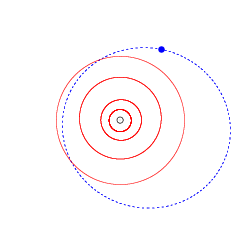Astronomy:(15788) 1993 SB
 | |
| Discovery[1] | |
|---|---|
| Discovered by | Iwan P. Williams, Alan Fitzsimmons, and Donal O'Ceallaigh La Palma (950) |
| Discovery date | 16 September 1993 |
| Designations | |
| none | |
| Minor planet category | Plutino[2][3] |
| Orbital characteristics[4] | |
| Epoch 13 January 2016 (JD 2457400.5) | |
| Uncertainty parameter 4 | |
| Observation arc | 5182 days (14.19 yr) |
| |{{{apsis}}}|helion}} | 51.860 astronomical unit|AU (7.7581 Tm) |
| |{{{apsis}}}|helion}} | 26.727 AU (3.9983 Tm) |
| 39.294 AU (5.8783 Tm) | |
| Eccentricity | 0.31981 |
| Orbital period | 246.32 yr (89967.0 d) |
| Average Orbital speed | 4.64 km/s |
| Mean anomaly | 349.75° |
| Mean motion | 0° 0m 14.405s / day |
| Inclination | 1.9398° |
| Longitude of ascending node | 354.93° |
| 79.441° | |
| Earth MOID | 25.7421 AU (3.85096 Tm) |
| Jupiter MOID | 21.655 AU (3.2395 Tm) |
| TJupiter | 5.337 |
| Physical characteristics | |
| Dimensions | 130 km |
| Absolute magnitude (H) | 7.9 |
(15788) 1993 SB is a trans-Neptunian object of the plutino class. Apart from Pluto, it was one of the first such objects discovered (beaten by two days by (385185) 1993 RO and by one day by 1993 RP), and the first to have an orbit calculated well enough to receive a number.[2] The discovery was made in 1993 at the La Palma Observatory with the Isaac Newton Telescope. Very little is known about the object. Even the diameter estimate of ~130 km is based on an assumed albedo of 0.09.[5]
KBO's found in 1993 include: (15788) 1993 SB, (15789) 1993 SC, (181708) 1993 FW, and (385185) 1993 RO.
Over one thousand bodies were found in a belt between orbiting between about 30-50 AU from the Sun in the twenty years (1992-2012), after finding 1992 QB1 (named in 2018, 15760 Albion), showing a vast belt of bodies more than just Pluto and Albion.[6][7] By 2018, over 2000 Kuiper belt objects were discovered.[7]
References
- ↑ "MPEC 1993-S09: 1993 SB". IAU Minor Planet Center. 1993-09-22. https://minorplanetcenter.net/mpec/J93/J93S09.html. Retrieved 2010-02-20.
- ↑ 2.0 2.1 "MPEC 2010-B62 :Distant Minor Planets (2010 FEB. 13.0 TT)". Minor Planet Center. 2010-01-30. https://minorplanetcenter.net/mpec/K10/K10B62.html. Retrieved 2010-02-20.
- ↑ Marc W. Buie. "Orbit Fit and Astrometric record for 15788". SwRI (Space Science Department). http://www.boulder.swri.edu/~buie/kbo/astrom/15788.html. Retrieved 2010-02-20.
- ↑ "15788 (1993 SB)". JPL Small-Body Database. NASA/Jet Propulsion Laboratory. https://ssd.jpl.nasa.gov/sbdb.cgi?sstr=15788;cad=1.
- ↑ Wm. Robert Johnston. "List of Known Trans-Neptunian Objects". Johnston's Archive. Archived from the original on 24 November 2005. https://web.archive.org/web/20051124045541/http://johnstonsarchive.net/astro/tnoslist.html. Retrieved 2006-02-07.
- ↑ "The Kuiper Belt at 20" (in en-US). 2012-09-01. https://www.astrobio.net/also-in-news/the-kuiper-belt-at-20/.
- ↑ 7.0 7.1 Dyches, Preston. "10 Things to Know About the Kuiper Belt". https://solarsystem.nasa.gov/news/792/10-things-to-know-about-the-kuiper-belt.
External links
- MPEC: recovery of the object
- list of known TNOs, including size estimates
- IAU minor planet lists
- (15788) 1993 SB at the JPL Small-Body Database
 |

